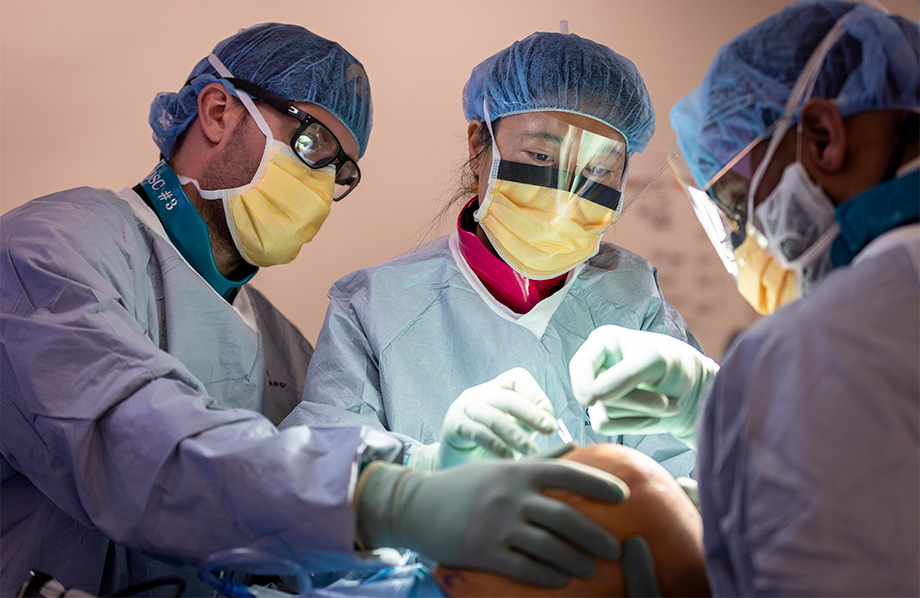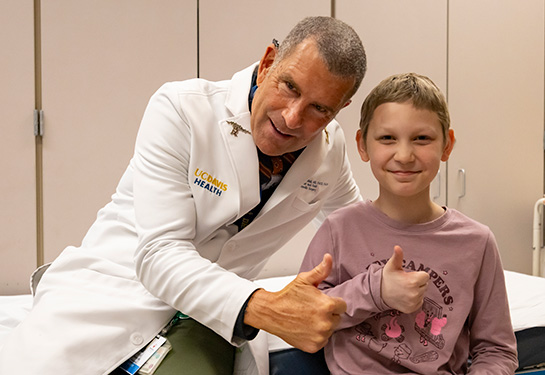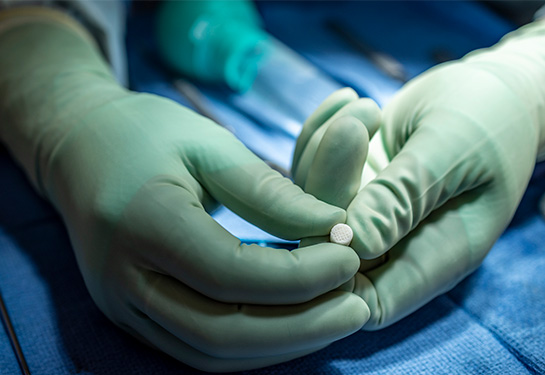Orthopaedic surgeon among first to place new shock absorber implant for knee pain
UC Davis Health’s Cassandra Lee offers solution for Tahoe-area firefighter’s chronic knee pain
Joe Barron underwent nearly a dozen knee surgeries and was starting to think there was no hope for relief from his pain — or to improve his quality of life.
Barron has dealt with knee issues since he was young. He has cartilage and meniscus damage on the inside of both knees, along with signs of early osteoarthritis. He hasn’t wanted to pursue a full knee replacement, because he’s still relatively young and active. Instead, he tried several other interventions — but nothing really worked.

The 54-year-old firefighter always ended up back in a knee brace after each procedure and couldn’t escape the pain and joint instability he has lived with for decades. He struggled to perform his physical tasks at work. And he couldn’t fully enjoy his life including outdoor activities that he loved around Tahoe.
So when UC Davis Health’s Cassandra Lee, chief of orthopaedic sports medicine, told him he was the perfect candidate for a new device that could help restore him to nearly full activity level, he was immediately interested.
Pursuing Leading-Edge Options
Lee learned about a new device that was being billed as a revolutionary solution for pain inside the knee. The MISHA Knee System is an implantable tool that acts like a shock absorber for the knee. It alleviates pressure on the joint, which eases pain and improves function for the patient.
“There’s nothing to compare it to,” Lee said. “It’s not like a knee replacement. It’s a completely new designation as a medical device.”

The MISHA Knee System was designed to be an option for people like Barron who are experiencing a prohibitive amount of pain and haven’t found relief from other treatments. It’s meant to prolong the need to seek a full joint replacement for patients who are young and don’t have advanced osteoarthritis that causes bone-on-bone pain.
“If you’re young and active, a knee replacement isn’t a great option,” Lee explained. “It never feels like your own knee.”
In this case, we tracked a new evidence-based approach as it was getting developed — and were able to offer cutting-edge medicine to our patients.”—Cassandra Lee, orthopaedic surgeon
Lee tracked the research and clinical trials and was excited to see promising data about patient outcomes. When the FDA cleared the device in 2023, she identified it as an exciting new option for patients like Barron — and something that could fill a huge need in her clinical work.
“I see a lot of patients who have debilitating cases of early arthritis and, historically, I’ve had very few tools in my belt that can help them get back to activity,” she said.
“To live his life, Joe had to be in a brace and there’s only so long you can do that.”

Getting Immediate Results
After studying and preparing for weeks, Lee performed one of the first MISHA Knee System procedures in the nation on Barron’s right knee in December 2023. She implanted the device, which is made of metal and polycarbonate urethane plastic, on the inside of his knee, where it attaches to the femur and tibia. It acts kind of like a marshmallow for the joint and absorbs the impact of each step Barron takes. The manufacturer of the device says it can reduce about 30% of peak force on the knee.
The surgery couldn’t have gone smoother, Lee said, calling the outpatient procedure “literally a textbook case.”
The MISHA Knee System is a less invasive surgery because it goes on top of the knee instead of violating the joint, she explained. This often means a faster recovery for patients.
And that proved to be the case for Barron, who was feeling noticeably better within a few days. Within a few weeks, he was easily performing tasks at work that had been challenging for years, like piling burning forest debris to reduce wildfire risk.
“This surgery has already made a greater difference than all of the other ones I’ve had,” he said. “It’s given me more stability and strength in my right knee than I’ve felt in years.”

Barron learned about Lee after seeing one of her research studies in his daughter’s hockey magazine and appreciated that she was pursuing innovative approaches to orthopaedic medicine.
“I was ready to throw in the towel when I saw Dr. Lee’s study and knew I wanted to reach out because I was looking for someone who could think outside of the box,” he said. “I’m so grateful she’s my doctor, because she’s always looking to the latest research and state-of-the-art advances to find the best solution to knee pain.”
Lee said UC Davis Health is a hub for innovation that fosters an environment where clinicians and scientists are empowered to pursue promising new solutions.
“In this case, we tracked a new evidence-based approach as it was getting developed — and were able to offer cutting-edge medicine to our patients,” she said.
There’s still a need for data that sheds light on the long-term outcomes for this device, Lee said. But it should give people like Barron the chance to participate in the activities they love, while significantly delaying the need to get a full knee replacement. In fact, Barron just got the left knee done in late April and is thrilled that he will be able to live with greater mobility, and much less pain.
“I’m excited that this device is going to allow me to do my job every day and to get back to recreation that I couldn't do in the past,” Barron said. “I can finally take advantage of the mountain environment I live in and do more outdoor activities than I ever could with the knee braces.”




